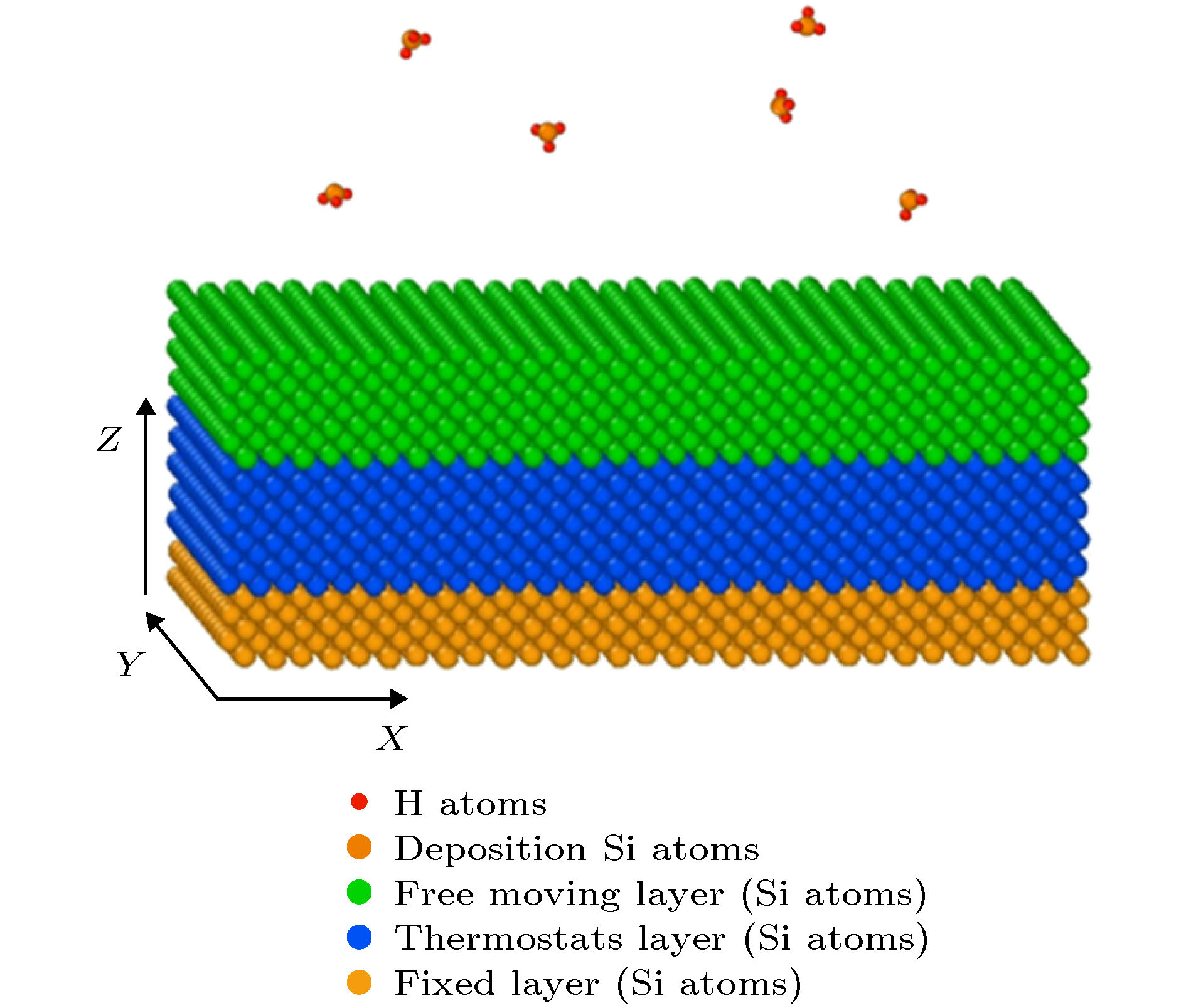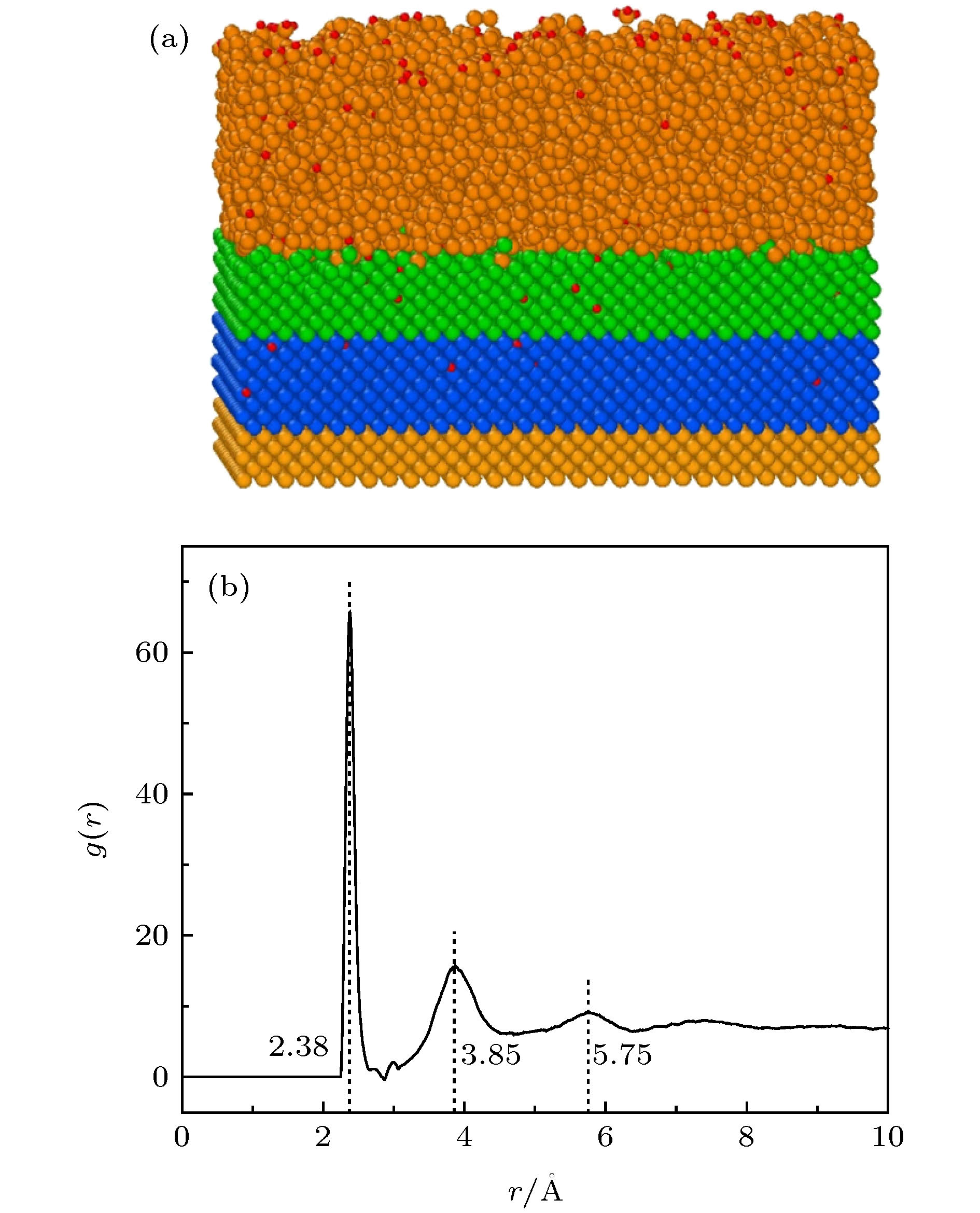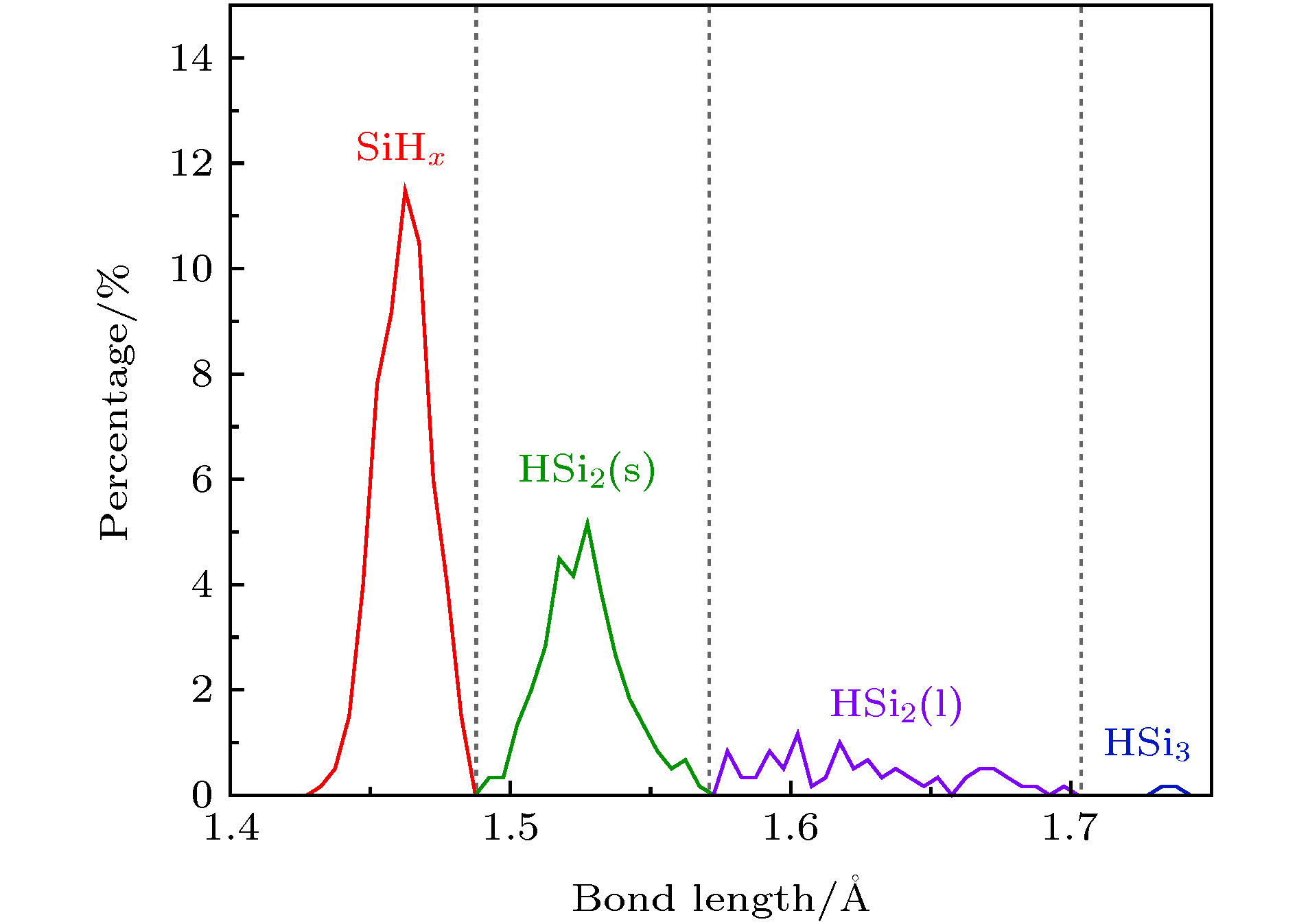-
The hydrogenated amorphous silicon (a-Si:H) film is the core structure of hetero junction with intrinsic thin layer solar cell. Its quality determinates the photoelectric conversion efficiency of this solar cell directly. The configuration of SiyHx is an important structure characteristic of a-Si:H films, and it can influence on the quality of a-Si:H thin films and their application properties. However, it is difficult to study them in depth and detail by the existing analytical and testing methods. In this paper, the structure configuration of SiyHx in a-Si:H /c-Si thin films and the effect of substrate temperature on its content have been simulated and analyzed by molecular dynamics method. A modified Tersoff potential developed by Murty was used to calculate the inter-atomic forces. The results showed that the SiyHx structure in a-Si:H thin films can be summarized into six configurations. Three traditional configurations, including SiH, SiH2 and SiH3, can be referred to as SiHx configurations.The other three nove configurations, including HSi2(s), HSi2(l) and HSi3, can be referred to as HSiy configurations. The main differences between the configurations of HSi2(l) and HSi2(s) are the longer Si—H bonds and bigger bond angle in HSi2(l) configuration than those in HSi2(s) configuration. All of the Si-H bonds in SiHx configurations are strong chemical bonds, while the Si—H bonds in HSiyconfigurations are weak physical bonds. The further calculations of the Si-H bond energies in six configurations have been carried out by the first principle method. According the bond energies results, we can deduce that the order of the stability of six configurations from high to low is SiH > SiH2 > SiH3 > HSi2(s) > HSi2(l) > HSi3. Comparing the Si—H bond energies of the six configurations with the solar energy, it is found that the Si-H bond energy in HSiy configuration is in the range of visible and infrared light in solar light. Si—H physical bonds are easy to fracture in HSiy configuration caused by solar light. This may be the main mechanism of producing Steabler-Wronski (S-W) effect in amorphous silicon thin film cells. In addition, the rise of substrate temperature in the deposition process of a-Si:H films will lead to a significant decrease in the configuration content of all kinds of SiyHx configurations.
-
Keywords:
- SiyHx configuration /
- bond energy /
- hydrogenated amorphous silicon thin films (a-Si:H) /
- molecular dynamics
[1] Yoshikawa K, Kawasaki H, Yoshida W, Irie T, Konishi K, Nakano K, Uto T, Adachi D, Kanematsu M, Uzu H, Yamamoto K 2017 Nat. Energy 2 17032
 Google Scholar
Google Scholar
[2] Liu J, Huang S H, He L 2015 J. Semicond. 36 4
 Google Scholar
Google Scholar
[3] Mishima T, Taguchi M, Sakata H, Maruyama E 2011 Sol. Energy Mater. Sol. Cells 95 18
 Google Scholar
Google Scholar
[4] Li Z, Zhang X W, Han G R 2010 Phys. Status Solidi A 207 144
 Google Scholar
Google Scholar
[5] Masuko K, Shigematsu M, Hashiguchi T, Fujishima D, Kai M, Yoshimura N, Yamaguchi T, Ichihashi Y, Mishima T, Matsubara N, Yamanishi T, Takahama T, Taguchi M, Maruyama E, Okamoto S 2014 IEEE. J. Photovoltaics 4 1433
 Google Scholar
Google Scholar
[6] Luo Y R, Gong H Y, Zhou N G, Huang H B, Zhou L 2018 Appl. Phys. A 124 18
 Google Scholar
Google Scholar
[7] Illiberi A, Creatore M, Kessels W M M, de Sanden M 2010 Phys. Status SolidiR 4 206
 Google Scholar
Google Scholar
[8] Bronsveld P C P, Mates T, Fejfar A, Kocka J, Rath J K, Schropp R E I 2010 Phys. Status Solidi A 207 525
 Google Scholar
Google Scholar
[9] Luo Y, Zhou N, Gong H, Huang H, Lang Z 2018 IOP Conf. Ser.: Mater. Sci. Eng. 284 012006
 Google Scholar
Google Scholar
[10] Hou G F, Fan Q H, Liao X B, Chen C Y, Xiang X B, Deng X M 2011 J. Vac. Sci. Technol., A 29 061201
 Google Scholar
Google Scholar
[11] Andujar J L, Bertran E, Canillas A, Roch C, Morenza J L 1991 J. Vac. Sci. Technol., A 9 2216
 Google Scholar
Google Scholar
[12] Staebler D L, Wronski C R 1977 Appl. Phys. Lett. 31 292
 Google Scholar
Google Scholar
[13] Zhang D, Tavakoliyaraki A, Wu Y, van Swaaij R, Zeman M 2011 Energy Procedia 8 207
 Google Scholar
Google Scholar
[14] Alnuaimi A, Islam K, Nayfeh A 2013 Sol. Energy 98 236
 Google Scholar
Google Scholar
[15] 秦国刚, 孔光临 1988 半导体学报 01 103
 Google Scholar
Google Scholar
Qin G G, Kong G L 1988 J. Semicond. 01 103
 Google Scholar
Google Scholar
[16] Murty M V R, Atwater H A 1995 Phys. Rev. B 51 4889
 Google Scholar
Google Scholar
[17] Tersoff J 1988 Phys. Rev. B 37 6991
 Google Scholar
Google Scholar
[18] Macrae C F, Bruno I J, Chisholm J A, Edgington P R, Wood P A 2008 J. Appl. Crystallogr. 41 466
 Google Scholar
Google Scholar
[19] Hafner J, Kresse G 1997 Properties of Complex Inorganic Solids (New York: Plenum Press) pp69–99
[20] Sriraman S, Agarwal S, Aydil E S, Maroudas D 2002 Nature 418 62
 Google Scholar
Google Scholar
[21] Robertson J 2000 J. Non-Cryst. Solids 266 79
 Google Scholar
Google Scholar
[22] Kim H, Horwitz J S, Kushto G, Piqué A, Kafafi Z H, Gilmore C M, Chrisey D B 2000 J. Appl. Phys. 88 6021
 Google Scholar
Google Scholar
-
图 6 不同衬底温度下沉积生长的a-Si:H/c-Si薄膜中的悬挂键、SiHx和HSiy相对含量(a), SiH, SiH2和SiH3的相对含量(b)和HSi2(s), HSi2(l)和HSi3相对含量(c)
Figure 6. Relative contents of dangling bonds, SiHx and HSiy(a), relative contents of SiH, SiH2 and SiH3 (b), and relative content of HSi2(s), HSi2 (l) and HSi3 (c) in a-Si:H/c-Si films deposited with different substrate temperatures.
-
[1] Yoshikawa K, Kawasaki H, Yoshida W, Irie T, Konishi K, Nakano K, Uto T, Adachi D, Kanematsu M, Uzu H, Yamamoto K 2017 Nat. Energy 2 17032
 Google Scholar
Google Scholar
[2] Liu J, Huang S H, He L 2015 J. Semicond. 36 4
 Google Scholar
Google Scholar
[3] Mishima T, Taguchi M, Sakata H, Maruyama E 2011 Sol. Energy Mater. Sol. Cells 95 18
 Google Scholar
Google Scholar
[4] Li Z, Zhang X W, Han G R 2010 Phys. Status Solidi A 207 144
 Google Scholar
Google Scholar
[5] Masuko K, Shigematsu M, Hashiguchi T, Fujishima D, Kai M, Yoshimura N, Yamaguchi T, Ichihashi Y, Mishima T, Matsubara N, Yamanishi T, Takahama T, Taguchi M, Maruyama E, Okamoto S 2014 IEEE. J. Photovoltaics 4 1433
 Google Scholar
Google Scholar
[6] Luo Y R, Gong H Y, Zhou N G, Huang H B, Zhou L 2018 Appl. Phys. A 124 18
 Google Scholar
Google Scholar
[7] Illiberi A, Creatore M, Kessels W M M, de Sanden M 2010 Phys. Status SolidiR 4 206
 Google Scholar
Google Scholar
[8] Bronsveld P C P, Mates T, Fejfar A, Kocka J, Rath J K, Schropp R E I 2010 Phys. Status Solidi A 207 525
 Google Scholar
Google Scholar
[9] Luo Y, Zhou N, Gong H, Huang H, Lang Z 2018 IOP Conf. Ser.: Mater. Sci. Eng. 284 012006
 Google Scholar
Google Scholar
[10] Hou G F, Fan Q H, Liao X B, Chen C Y, Xiang X B, Deng X M 2011 J. Vac. Sci. Technol., A 29 061201
 Google Scholar
Google Scholar
[11] Andujar J L, Bertran E, Canillas A, Roch C, Morenza J L 1991 J. Vac. Sci. Technol., A 9 2216
 Google Scholar
Google Scholar
[12] Staebler D L, Wronski C R 1977 Appl. Phys. Lett. 31 292
 Google Scholar
Google Scholar
[13] Zhang D, Tavakoliyaraki A, Wu Y, van Swaaij R, Zeman M 2011 Energy Procedia 8 207
 Google Scholar
Google Scholar
[14] Alnuaimi A, Islam K, Nayfeh A 2013 Sol. Energy 98 236
 Google Scholar
Google Scholar
[15] 秦国刚, 孔光临 1988 半导体学报 01 103
 Google Scholar
Google Scholar
Qin G G, Kong G L 1988 J. Semicond. 01 103
 Google Scholar
Google Scholar
[16] Murty M V R, Atwater H A 1995 Phys. Rev. B 51 4889
 Google Scholar
Google Scholar
[17] Tersoff J 1988 Phys. Rev. B 37 6991
 Google Scholar
Google Scholar
[18] Macrae C F, Bruno I J, Chisholm J A, Edgington P R, Wood P A 2008 J. Appl. Crystallogr. 41 466
 Google Scholar
Google Scholar
[19] Hafner J, Kresse G 1997 Properties of Complex Inorganic Solids (New York: Plenum Press) pp69–99
[20] Sriraman S, Agarwal S, Aydil E S, Maroudas D 2002 Nature 418 62
 Google Scholar
Google Scholar
[21] Robertson J 2000 J. Non-Cryst. Solids 266 79
 Google Scholar
Google Scholar
[22] Kim H, Horwitz J S, Kushto G, Piqué A, Kafafi Z H, Gilmore C M, Chrisey D B 2000 J. Appl. Phys. 88 6021
 Google Scholar
Google Scholar
Catalog
Metrics
- Abstract views: 10727
- PDF Downloads: 155
- Cited By: 0















 DownLoad:
DownLoad:





